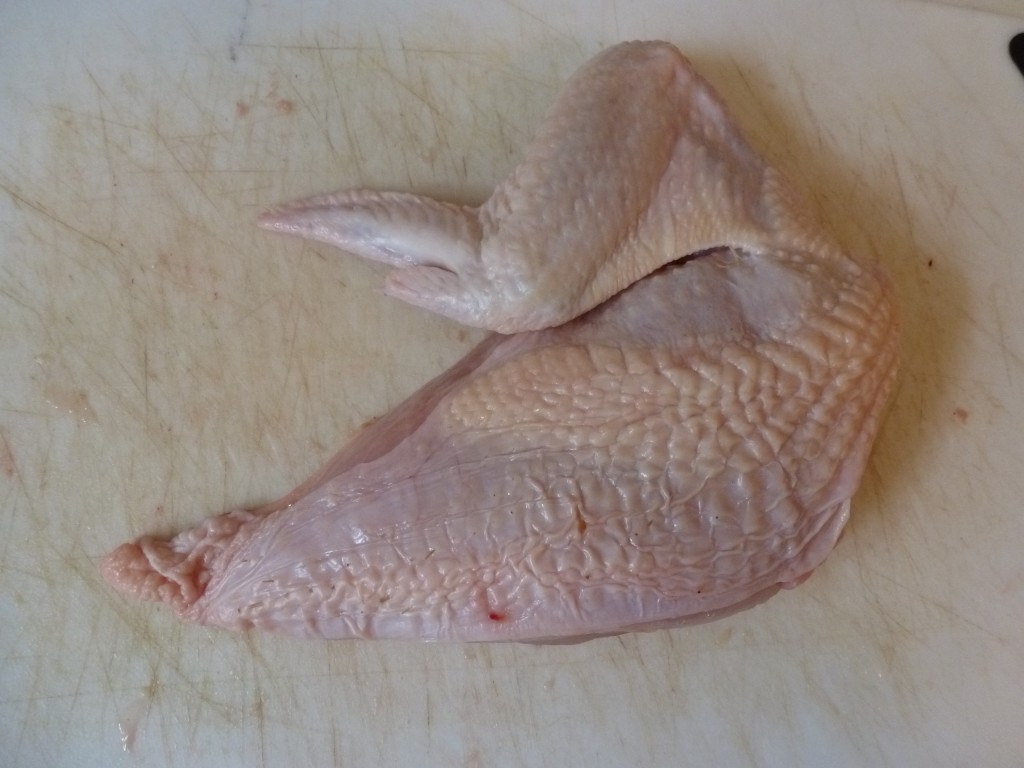The latest in the “Cutting Whole Animals” series on Button Soup: a general approach for cutting poultry.
The general skeletal and muscular structure is almost identical for all meat birds. Proportions of wing to breast to leg will vary, but the following procedure will work for chickens, turkeys, ducks, geese, and guinea hens, as well as game birds like pheasants, grouse, partridge, and so on.
This is a whole chicken. It’s from Four Whistle Farms. It weighs about 3 kg.
Removing the Legs
The legs pull easily from the body. You can see a good deal of loose skin between the leg and body.
Cut the skin and pull the leg farther from the body.
Bend the leg behind the bird to snap the joint where the thigh bone meets the hip. You can see the exposed joint in the picture below.
There is a pocket of dark, tender, flavourful meat on the back side of the bird, at the top of the hip bone, on either side of the back bone. This is called the oyster meat, or simply the oyster, because of its uniform, round shape. We want to make sure that the oyster meat is removed with the leg. Otherwise it would be left on the bird and end up in the stock pot. I locate the oyster, then use my thumb to pop it out of the hip.
Cut around the oyster, then through the broken joint, and follow the meat as closely to the body of the bird to remove the leg.
Repeat the process on the other side.
Now we have a legless bird:
Removing the Breasts and Wings
Birds have a very pronounced sternum, which cooks call the keel bone.
Make a cut just off centre and follow the keel down to the rib cage.
Now make small, exploratory cuts, following the rib cage and pulling back the breast as you go:
Eventually you will expose the joint where the wing meets the shoulder.
Break and sever the joint to remove the breast-wing.
Repeat the procedure on the other side of the bird.
This is the remaining carcass. There is still some good meat on it, especially along the back and neck. These pieces certainly can be roasted or fried, but I typically use them in stock. The meaty back adds flavour, the neck gelatin.
Depending on the size of your bird and pot, you may want to break the carcass into smaller pieces. The back actually separates quite easily from the rib cage and neck. Simply bend to snap.
Dividing the Leg into a Thigh and a Drumstick
This is one of the legs we removed from the bird:
Here is the other side of the leg, the side once attached to the body. There are two parts to a chicken leg: the thigh and the drumstick. You can see that they form something close to a right angle.
Cut away the meat where the drum and thigh meet, then snap and sever the joint.
Dividing the Breast and Wing
This is the breast and wing from one side of the bird. The wing has three main sections. Starting at the breast they are the drumette, the wingette, and the wingtip. I’m sure you are familiar with the two types of chicken wings that you get at a bar. The one that looks like a small drumstick is the drumette. The wingette is the one that is flat, long, and has two slender bones arching through its length. There is some debate as to which is superior. For my money, the wingette is more moist, and I enjoy eating the meat from between the two bones.
Whichever is your favourite, you should only date people who like the other part of the chicken wing, so that you can share a basket without fighting.
The wingtip is not typically served. I put it in my stockpot.
If you leave the wing on the breast the piece of meat is called a supreme. This is a very elegant cut of meat.
While traditionally the whole wing might have been left on the breast, today it is more common to see just the drumette.



















